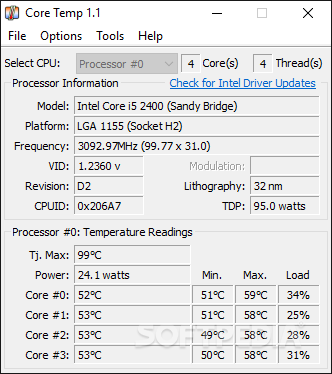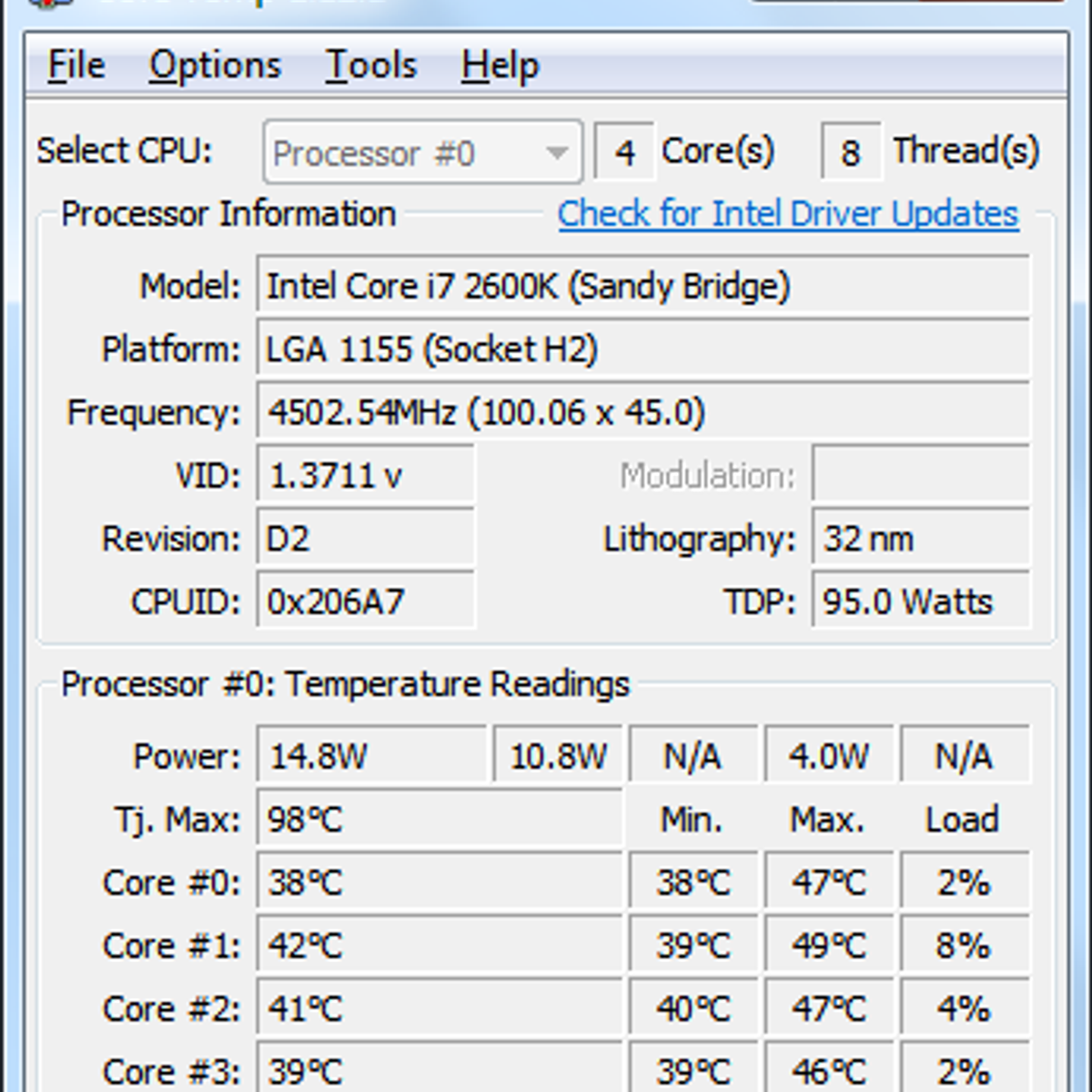- Core Temperature
- Core Temperature
Once Core Temp is open, you can view your average CPU temperature by looking at the bottom right hand side of the window. You'll be able to see the min and max values in Celsius. Below you'll see what Core Temp looks like for an AMD processor and an Intel processor. You can take a temperature using the mouth (oral), anus (rectal), armpit (axillary), or ear (tympanic). But the temperature readings vary depending on which one you use, and you need an accurate body temperature to determine if a fever is present. Medical research. Core temp free download - Core Temp, Core Temp MC, Core Temp Monitor Lite, and many more programs. Install and run it and you will see the temperature for each CPU core of the CPU. Importantly, you'll also see the Tj. Izotope trash 2 05d. Max figure, which is the temperature at which the chip will throttle back.
Also found in: Dictionary, Thesaurus, Acronyms, Encyclopedia, Wikipedia.
temperature
[
tem´per-ah-chur] the degree of sensible heat or cold, expressed in terms of a specific scale. See Table of Temperature Equivalents in the Appendices. Body temperature is measured by a clinical thermometer and represents a balance between the heat produced by the body and the heat it loses. Though heat production and heat loss vary with circumstances, the body regulates them, keeping a remarkably constant temperature. An abnormal rise in body temperature is called
fever.
Normal Body Temperature. Body temperature is usually measured by a thermometer placed in the mouth, the rectum, or the auditory canal (for tympanic membrane temperature). The normal oral temperature is 37° Celsius (98.6° Fahrenheit); rectally, it is 37.3° Celsius (99.2° Fahrenheit). The tympanic membrane temperature is a direct reflection of the body's core temperature. These values are based on a statistical average. Normal temperature varies somewhat from person to person and at different times in each person. It is usually slightly higher in the evening than in the morning and is also somewhat higher during and immediately after eating, exercise, or emotional excitement. Temperature in infants and young children tends to vary somewhat more than in adults.
Temperature Regulation. To maintain a constant temperature, the body must be able to respond to changes in the temperature of its surroundings. When the outside temperature drops, nerve endings near the skin surface sense the change and communicate it to the hypothalamus. Certain cells of the hypothalamus then signal for an increase in the body's heat production. This heat is conducted to the blood and distributed throughout the body. At the same time, the body acts to conserve its heat. The arterioles constrict so that less blood will flow near the body's surface. The skin becomes pale and cold. Sometimes it takes on a bluish color, the result of a color change in the blood, which occurs when the blood, flowing slowly, gives off more of its oxygen than usual. Another signal from the brain stimulates muscular activity, which releases heat. Shivering is a form of this activity—a muscular reflex that produces heat.
When the outside temperature goes up, the body's cooling system is ordered into action. Sweat is released from sweat glands beneath the skin, and as it evaporates, the skin is cooled. Heat is also eliminated by the evaporation of moisture in the lungs. This process is accelerated by panting.
An important regulator of body heat is the peripheral capillary system. The vessels of this system form a network just under the skin. When these vessels dilate, they allow more warm blood from the interior of the body to flow through them, where it is cooled by the surrounding air.
Abnormal Body Temperature. Abnormal temperatures occur when the body's temperature-regulating system is upset by disease or other physical disturbances. fever usually accompanies infection and other disease processes. In most cases when the oral temperature is 37.8°C (100°F) or over, fever is present. Temperatures of 40°C (104°F) or over are common in serious illnesses, although occasionally very high fever accompanies an illness that causes little concern. Temperatures as high as 41.7°C (107°F) or higher sometimes accompany diseases in critical stages. Subnormal temperatures, below 35.6°C (96°F) occur in cases of collapse; see also symptomatic hypothermia.
absolute temperature (T) that reckoned from absolute zero (−273.15°C), expressed on an absolute scale.
basal body temperature (BBT) the temperature of the body under conditions of absolute rest; it has a slight sustained rise during the luteal phase of the menstrual cycle and can be used as an indirect indicator of when ovulation has occurred.
body temperature the temperature of the body of a human or animal; see temperature.
core temperature the temperature of structures deep within the body, as opposed to peripheral temperature such as that of the skin.
critical temperature that below which a gas may be converted to a liquid by increased pressure.
normal temperature the body temperature usually registered by a healthy person, averaging 37°C (98.6°F).
risk for imbalanced body temperature a nursing diagnosis accepted by the North American Nursing Diagnosis Association, defined as a state in which an individual is at risk of failure to maintain body temperature within the normal range.
subnormal temperature temperature below the normal. See also symptomatic hypothermia.
Miller-Keane Encyclopedia and Dictionary of Medicine, Nursing, and Allied Health, Seventh Edition. © 2003 by Saunders, an imprint of Elsevier, Inc. All rights reserved.
core temperature
The temperature at which vital organs (e.g., brain, heart) are maintained; it is practically measured sublingually (where it is 0.25 to 0.5ºC cooler than when measured by probes in the oesophagus, nasopharynx or rectum). The core temperature of the human body is usually between 36–37.5ºC, with daily variation (lowest in the early hours of the morning) and monthly variation in women during ovulation.
Segen's Medical Dictionary. © 2012 Farlex, Inc. All rights reserved.
core tem·per·a·ture
(
kōr tem'pĕr-ă-chŭr)
Medical Dictionary for the Health Professions and Nursing © Farlex 2012
core temperature (Tc )
the mean temperature of the tissues of organisms at a depth below that directly affected by a change in the AMBIENT temperature. T



